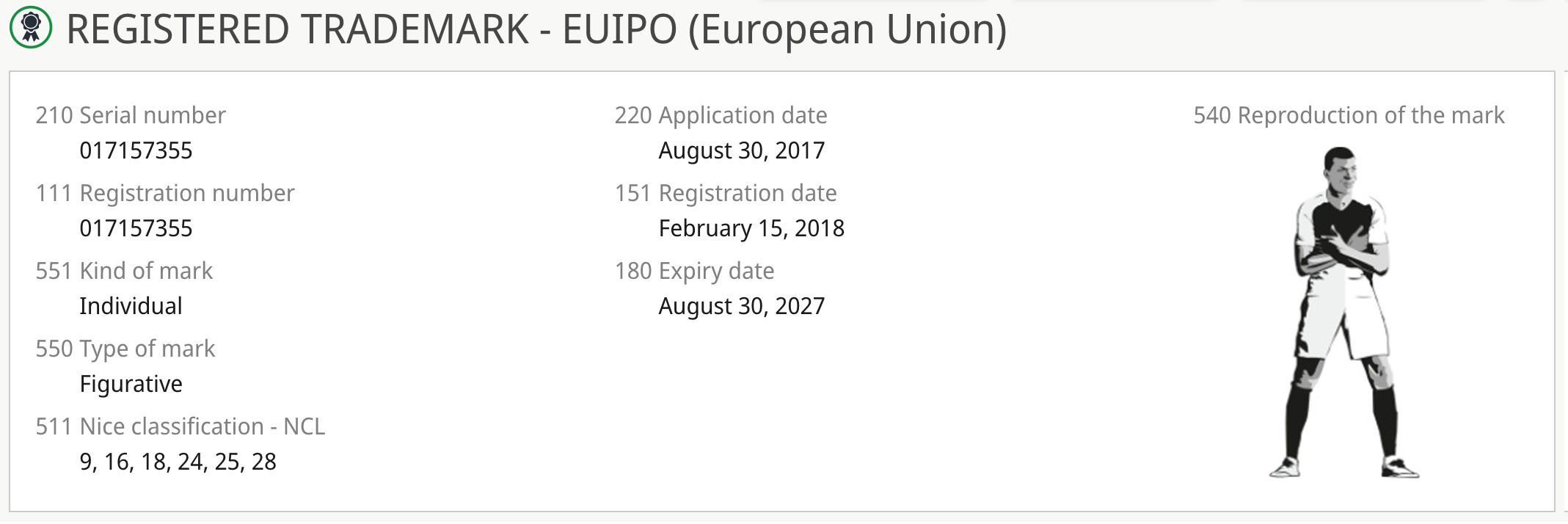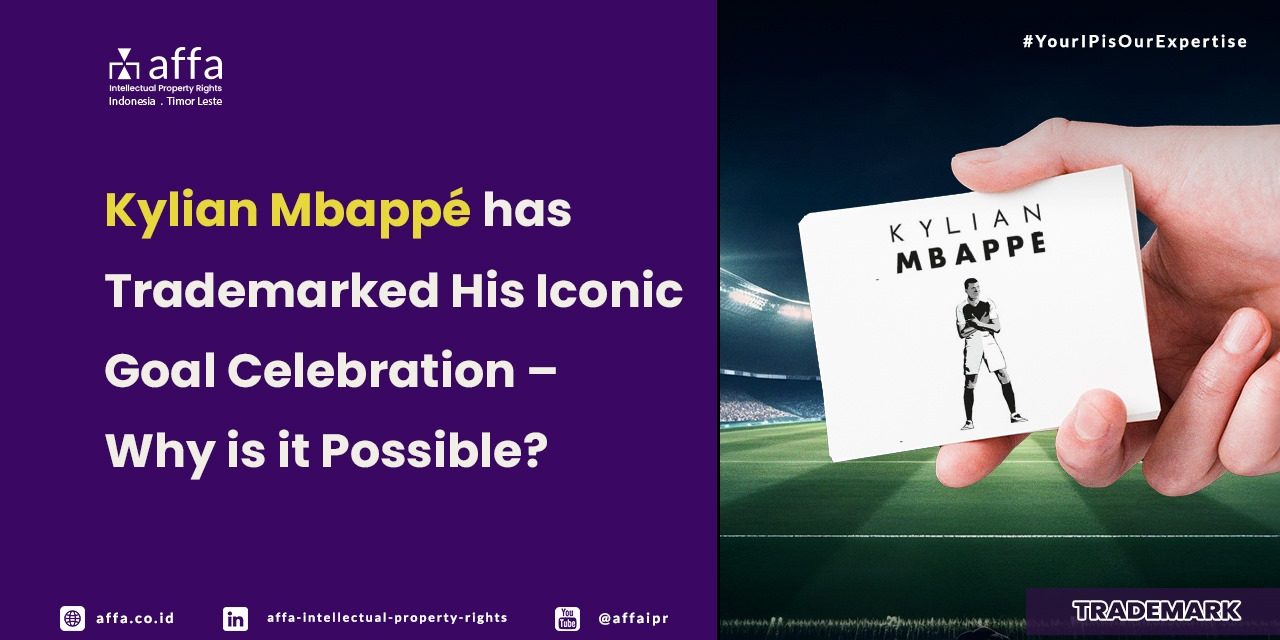Since 2017, Kylian Mbappé has contributed 170+ goals for the Paris Saint-Germain football club. Since then, Mbappé has introduced a celebration pose with crossed arms clamped in his armpits after he scores. Apparently, the pose was registered as a Trademark in the same year and will be protected at least until August 2027.
In theory, since 2008, the World Intellectual Property Organization (WIPO) has recognized the existence of ‘New Types of Marks,’ which divides Trademarks into two types, namely Visible and Non-Visible. For Visible Marks, apart from the various commonly recognized Marks such as names, logos, and holograms, Motion or Multimedia Signs, Position Marks, and Gesture Marks are also recognized. Therefore, this celebratory pose, which includes gestures, can indeed be registered as a Trademark.
 Source: World Intellectual Property Organization (WIPO)
Source: World Intellectual Property Organization (WIPO)
As a logo, there is a classification system that regulates it to make applications more accessible, as well as providing ample opportunity for each person or company logo to be registered in various appropriate class categories, thereby minimizing monopolistic practices. The classification system is the Vienna Class, which divides logos into 29 categories, 144 divisions, 775 main sections, and 1,112 auxiliary sections. Mbappé’s celebration pose is included in Vienna Class 2.1.8 which includes logos for “Acrobats, athletes, dancers, jugglers, nude men, men practising sports (except those already included in Vienna Classes 2.1.2, 2.1.12, 2.1.14, 2.1.20 and 2.1.21).”
It should be noted that the Indonesian Trademark Office (DGIP) has not adopted the Vienna Class for Figurative Mark, but this does not mean that the Mark cannot be registered in Indonesia. Please take a look at the explanation at the end of this article.
Why Does It Need to be Trademarked?
From the start, Mbappé understood that his unique pose could be registered as a Trademark. Dozens of years earlier, David Beckham, the legendary wing midfielder from Manchester United, had registered his cross-passing pose as a Trademark. The difference is that the logo registered by Beckham is a figure that resembles a human (Vienna Class 4.5.5), not a black-and-white photo of himself as registered by Mbappé.
 Source: World Intellectual Property Organization (WIPO)
Source: World Intellectual Property Organization (WIPO)
However, just like Beckham, Mbappé also hopes that this Trademark can be used commercially for various goods and/or services of his own. With global achievements and 113 million Instagram followers from all over the world, it is not difficult to imagine that whatever Mbappé sells, especially those with his unique celebration logo, will make a profit. Of course, this profit does not only come to Mbappé but also to manufacturers of clothes, textiles, toys, video games, umbrellas, bags, jewelry, perfume, cosmetics, and even toothbrushes who are interested in getting the license.
Negative Impact on the Athlete’s Image?
If a Trademark is already registered, commercial use of the mark becomes the exclusive right of the mark owner or another party who has officially obtained permission. So, suppose another party uses it without permission. In that case, a civil lawsuit can be filed in Indonesia, or criminal liability can be demanded, with a maximum fine of 2 (two) billion Rupiah or a maximum imprisonment of 5 (five) years.
From the perspective of the fan community, the size of this fine can be scary because a logo that was previously very proud, used as wallpaper on a cellphone, laptop, sticker on a vehicle, or poster in the work space could become incriminating evidence. Will Mbappé’s lawyers or legal team sue and imprison the Fans?
The answer is, of course, no. Because they will mainly pursue pirates who produce, distribute, or sell counterfeit products without permission, this effort is undoubtedly very positive for fans who are truly present to provide support to their athletes. Because the money spent will actually be income for the athletes, not put into the pockets of the pirates, it’s more expensive but legal, you get quality goods, and you’re prouder.
Other Athletes Who Have Done It, Too.
The practice of commercializing athletes’ profiles as Trademarks has been going on for a long time; for example, basketball player Michael Jordan, golfer Jack Nicklaus, and sprinter Usain Bolt are still loved by their fans. With the ownership of this celebration logo, Mbappé is recorded as having 7 registered Trademark variants at the European Union Intellectual Property Office (EUIPO), of which 1 is a Trademark bearing his name, 2 Trademarks contain his favorite slogan, 2 are his logo, and 2 more are a combination of logo and Mbappé’s name.
Lionel Messi (6 Marks) and Cristiano Ronaldo (5 Marks) are other footballers with many active registered Trademarks. However, when David Beckham was still active, he had more Trademarks. Namely, he had 8 registered Trademarks for the logo, name, and several variants of his name with a combination of his back numbers for various products and foundations that he owns. Unfortunately, currently, only one Trademark is still active: BECKHAM.
Can this Trademark be Registered in Indonesia?
Referring to Article 1 point 1 of Law Number 20 of 2016 on Trademarks and Geographical Indications (the Trademark Law), a Trademark is a sign that can be displayed graphically in the form of an image, logo, name, word, letter, number, color arrangement, in the form of 2 (two) dimensions and/or 3 (three) dimensions, sound, hologram, or a combination of 2 (two) or more of these elements to differentiate goods and/or services produced by individuals or legal entities in goods and/or services trading activities.
Referring to the Trademark definition, the Trademark submitted by Kylian Mbappé can also be registered in Indonesia as long as no identical or similar Mark has been previously submitted by another party, as regulated in Article 21 of the Trademark Law.
Are you interested in registering your name or favorite pose as a Trademark in Indonesia or abroad? Contact us directly via email: [email protected].








1 Comment